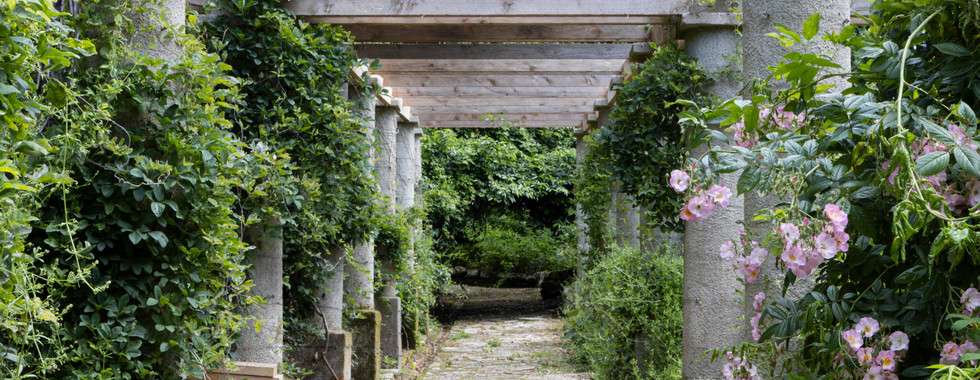Great Ambrook Italian Garden: A Devonshire Rhapsody in Stone and Seed
- Vicki Gardner
- Apr 2
- 6 min read
Nestled deep within the verdant, rolling hills of South Devon, lies a hidden gem, a testament to a bygone era of leisure, artistry, and veiled secrets: The Italian Garden at Great Ambrook. This Grade II listed garden, a sprawling four-acre tapestry of horticultural and architectural brilliance, whispers stories of its fascinating past, inviting visitors to step back in time and immerse themselves in its unique charm.

A Visionary's Dream: The Genesis of Great Ambrook
The story of this enchanting garden begins in 1901 when Arthur Smith Graham acquired the Great Ambrook estate. A man of vision and refined taste, Graham commissioned Thomas Lyon, a local architect and the first Director of the Cambridge School of Architecture, to design a garden that would be unlike any other. Built between 1909 and 1912 by Lewis Bearn, the same craftsman behind the imposing Castle Drogo and Bovey Castle, the Italian Garden was conceived as a journey, a carefully orchestrated walk through intersecting paths of Portland stone, laid in a charming "crazy" paved style.
Lyon masterfully exploited the sloping landscape, incorporating an old quarry and former carrion pit into the design, and framing breath-taking views of the surrounding countryside. The result is a harmonious blend of styles, where the romanticism of the Landscape style intertwines with Mediterranean influences and the craftsmanship of the Arts and Crafts movement. Modern techniques, such as cement render and fabricated steel sections, were seamlessly integrated, showcasing a forward-thinking approach to garden design.
Graham, an avid plant enthusiast, cultivated a rich variety of flora in his garden, including specimens sourced from the renowned Rovelli brothers' nursery near Lake Maggiore, Italy. Impressively, some of these original plantings still flourish today, showcasing Graham's horticultural foresight. Recent additions, such as Trachelospermum jasminoides planted in the North Walk border in 2020 and procured from Matteini Tranquillo nursery in Pistoia, Italy, honour the garden's Italian heritage. Contemporary elements like Agapanthus and Hosta cultivars adorning the granite planters bring modern aesthetics to the space. Furthermore, many new plants have been selected for their benefits to wildlife and pollinators, ensuring ecological harmony.

Secrets Shrouded in Stone: Privacy and Leisure in a Changing World
The Italian Garden was designed with social life and recreation at its heart, yet it also provided a sanctuary of privacy and seclusion. Graham was a homosexual at a time when Victorian laws still harshly punished same-sex acts. The garden, set away from the main house and enclosed on three sides by rendered walls reaching up to 15 feet, offered a discreet haven for Graham and his guests. These walls, along with most of the garden's structures, were meticulously wired for climbing plants, creating a verdant curtain of seclusion. Much of this original wiring remains today, a poignant reminder of the garden's hidden history.
Features within the garden further emphasized its purpose as a place of leisure and relaxation. A grand 33-foot semi-circular terrace at the garden's summit offered panoramic views and served as a central meeting point. Beneath the terrace, a spring-fed water tank supplied a complex water system, feeding stone tanks throughout the garden and the rills that gracefully flowed alongside the paths.
The original entrance archway, located beside the terrace, led to the two-storied summerhouse or observatory. This charming structure, originally topped with a domed ogival roof, featured an upper storey with a terracotta-tiled floor and an external staircase. Octagonal windows adorned the ground floor room, which has recently been lovingly restored with a new wooden door and replaced windows. In the centre of the terrace stands a Portland stone and sandstone plinth, once the proud home of a sundial. Towering over the terrace and summerhouse, two magnificent specimen trees, a Quercus ilex (holm oak) and Quercus sober (cork oak), believed to be from the original planting, add to the garden's timeless allure.

A Walk Through Time: Exploring the Garden's Key Features
Descending from the observatory and terrace along the South Walk, visitors encounter the enchanting 111-foot pergola, crafted with concrete-rendered brick columns. This gently sloping structure, running beside a shallow wall and perpendicular to the Palm Walk, still boasts its original planting of Akebia quinata (Chocolate vine), Vitis cognetiae (Crimson Glory Vine), and an unidentified rambling rose. When the garden was rediscovered in 2016, the pergola timbers were in a state of decay, but dedicated volunteers worked tirelessly during the Covid epidemic to replace them in the original design.
The Palm Walk connects the Central Walk and The Dell to the pergola and a gate leading to farmland, known as the Peacock Field. Towering Trachycarpus fortunei (Chusan Palm), affectionately known as 'Great Ambrook palms', line both sides of the Palm Walk, creating a dramatic and exotic atmosphere. These palms have self-seeded prolifically, and the volunteers have carefully filled gaps in the Palm Walk with these offspring.

Continuing through the pergola, the path leads to the swimming pool and sunbathing terrace, complete with a stone bench and low walls offering views of the surrounding countryside. Dartmoor granite pillars stand guard over one half of the pool, hinting at a pergola that once provided shade and privacy. The Apostles Walk, lined with 12 Thuja plicata (Western red cedars) and holly, links the swimming pool to the old Rose Garden, now planted with vibrant azaleas. Behind the Rose Garden stands the imposing Tennis Pavilion, raised above the old court, and featuring a large octagonal plunge pool and a beautiful, curved bench made of Ipplepen marble overlooked by a huge Gingko biloba (Maidenhair tree) thought to be from the original planting scheme.

Rediscovering the Lost Dell: A Transformation from Quarry to Sanctuary
A path leading down from the uncovered viewing terrace offers a glimpse into The Dell, once a quarry and carrion pit. Through the tireless efforts of volunteers, a network of paths has been uncovered, creating an enchanting and secluded space. At the bottom of The Dell, a cave or grotto awaits, while new plantings of ferns, campanulas and geraniums sprawl around. Tree ferns and New Zealand flax adorn the Dell's banks. Above the dell, a new stumpery has been created, using repurposed earth and tree stumps to showcase a variety of ferns, hostas, hellebores, crocosmia and other woodland plants.

A New Chapter: Restoration and Renewal
Upon Graham's death in 1928, he ordered all photos and paperwork of his to be destroyed, and the estate passed through several hands. In the 1950s and 60s, the garden fell into neglect, becoming so overgrown that its existence was all but forgotten. It wasn't until 1988 that the garden was rediscovered by its then-owners, Mr. and Mrs. Kenneth Rees. They began the arduous task of uncovering and maintaining what they could, until Kenneth Rees took on a gardener at the age of 83.
In 2016, friends Stephanie Berry, Kim Chapman and their families purchased the gardens and embarked on a mission to restore the Italian Garden to its former glory. Their aims are clear: to "reinforce the Italianate characteristics of the garden whilst retaining its beguiling character and adapting the original planting to today's warmer climate" and "to create a hidden haven for people and wildlife alike – a place of well-being."
Today, the Italian Garden is a Community Interest Company (CIC), supported by a dedicated team of 34 volunteers. The garden hosts a variety of events, including guided walks, forest bathing, well-being, photography and art workshops. Two National Lottery Heritage grants in 2020 and 2023 have enabled remedial work on the garden's structures, improved on-site facilities, and provided specialist skills training for volunteers.

A Garden for the Future: Sustainability and Community
The Italian Garden's commitment to sustainability is evident in its composting areas, meticulously managed by volunteers. The garden also features a nursery, where young plants are nurtured to be sold to visitors. Situated within the Italian Garden is a modern, sleek 3-bedroom self-catering holiday home, with all profits from rentals going towards maintaining the Italian Garden. The Garden House, built within the old orchard and walled kitchen garden, has retained the old apple trees and features a new planting scheme designed to encourage wildlife and pollinators.
The Italian Garden at Great Ambrook is more than just a garden; it's a living testament to the power of vision, dedication, and community. It's a place where history and nature intertwine, offering visitors a unique and unforgettable experience.
Visiting the Italian Garden
The Italian Garden is open by appointment only or through scheduled events. For more information, including details of guided walks, workshops, and other events, please visit theitaliangarden.org or follow the garden on Facebook (The Italian Garden at Great Ambrook) or Instagram (Italiangardenambrook).





































































Comments